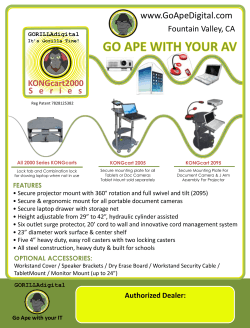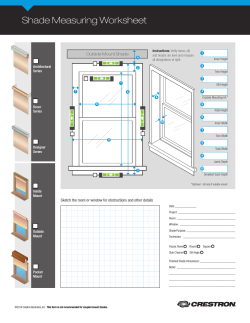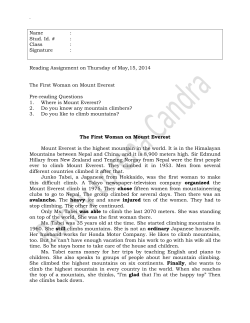
NTEQ LESSON PLAN
NTEQ LESSON PLAN LESSON TITLE: ADVENTURES IN NONFICTION SUBJECT AREA(S): ENGLISH 10 GRADE LEVEL: 10TH LESSON SUMMARY Students need to be skilled readers of nonfictional texts. To do so students should understand that background knowledge may be necessary to understand and comprehend many nonfictional texts. Today’s lesson will prepare students to read a nonfictional text and, because of prior knowledge done through research, make connections to the texts to improve comprehension. Students will collaboratively research information on Mount Everest and/or climbing Mount Everest before reading the nonfiction text Into Thin Air by Jon Krakauer. LEARNING OBJECTIVES By the end of this lesson, the students will: Using a PC/ cellular device complete guided question stems collaboratively and present their findings to the class using either Power Point/ Prezi with at least 80% accuracy. Have the background knowledge needed to better comprehend and make connections to the reading selection. STANDARDS National: N/A English Standards of Learning Curriculum Framework 2010- Grade 10; Board of Education, Commonwealth of Virginia 10.2a: Use media, visual literacy, and technology skills to create products 10.1b: Collaborate in the preparation or summary of the group activity 10.2b: Evaluate sources including advertisements, editorials, blogs, web sites, and other media for relationships between intent, factual content, and opinion MATERIALS Electronic devices (PCs, cellular devices, laptops) Data Projector/ Smart Board Think Sheet of informational websites KWL Graphic Organizer Kahoot.it website Think Sheet of guided questions Power Point/ Prezi Internet connection Google Docs for collaboration COMPUTER FUNCTIONS AND DATA MANIPULATION Computer Function Digital Tool to gather, evaluate, and use data Computer Application Presentation of Findings Assessment of comprehension Data Manipulation Assess credibility of information SPECIFY PROBLEM Today we are going to investigate Mount Everest. What challenges would you face if you were to add climbing Mount Everest to your bucket list? RESULTS PRESENTATION Students will collaboratively present their findings to the class and assess their peer’s comprehension of information presented. MULTIDIMENSIONAL ACTIVITIES Briefly describe the lesson activities. Begin with the Lesson Introduction or how you will introduce the problem and how you will address prerequisite skills, share learning objectives, and provide needed information. As you describe the computer activities, please include what students need to do before they go the computers, while they are at the computers, and what they do after they finish computer work. Descriptions of the supporting activities follow the computer activities. This form has space for three computer and three supporting activities. When you design your lesson, include the appropriate number of each for your particular lesson. After these activities are planned, describe the Culminating Activity, or how main ideas will be reviewed and/or final presentations given. When these components are planned describe the rotation plan – how will students rotate between the activities. LESSON INTRODUCTION – Briefly describe how you will introduce the problem and how you will address any prerequisite skills, share learning objectives, and provide needed information. 1. SHOW FIRST 1:55 MINUTES OF HTTPS://YOUTU.BE/V7CMD-FADBG VIDEO CLIP 2. The problem will be introduced: Today we are going to investigate Mount Everest. What challenges would you face if you were to add climbing Mount Everest to your bucket list? 3. Students will complete the “K” and “W” of KWL graphic organizer about Mount Everest. 4. The learning objective will be introduced: Using a PC/ cellular device complete guided question stems collaboratively and present their findings to the class using either Power Point/ Prezi with at least 80% accuracy. 5. Grading rubric distributed and explained. 6. Class divided into collaborative groups. COMPUTER ACTIVITIES Activity 1 Activities to be completed: Prior to going to computer 1. Think Sheets: How to work collaboratively 2. Job/ responsibilities assignments At the computer 3. Evaluation of sites for information 4. Answer question stems using info gathered 5. Adding info collected to Google Docs After going to computer 6. Group evaluation of information for interest level and importance. 7. Activity 2 Activities to be completed: Prior to going to computer 8. Review assignment rubric 9. Create storyboard for Elimination of irrelevant info Activity 3 Activities to be completed: Prior to going to computer 14. Think Sheets: Question Stems 15. Creation of questions for presentation At the computer 10. Evaluate sites for relevant graphics/ videos 11. 12. Create Power Point/ Prezi presentation of information following storyboard assessment of presentation comprehension At the computer 16. Creation of quiz in KAHOOT.IT using questions composed in group 17. Group “dry-run” of KAHOOT.IT quiz Group evaluation of presentation using rubric After going to computer 13. Group creation of script for presentation to class After going to computer 18. Complete KWL graphic organizer “L” section for Mount Everest SUPPORTING ACTIVITIES Activity 1 Activities to be completed: 19. 20. 21. Job assignment titles and responsibilities sheet List of databases and credible websites for information GoogleDocs page for collection of data Activity 2 Activities to be completed: 22. 23. Thinking Map Flow Map for storyboard creation MSWord typed script for group presentation Activity 3 Activities to be completed: 24. 25. List of question stems completed and uploaded in GoogleDocs Complete KWL chart for Mount Everest CULMINATING ACTIVITY – Briefly describe how main ideas will be reviewed and/or final presentations given. Using a PC and a SmartBoard/ Data Projector students will present their Power Point / Prezi presentations to the class. Group members will take turns speaking/ presenting their findings to the class. At the end of each presentation the presenters will evaluate their peers with 5-8 questions on the information presented using Kahoot.it website (Personal Response System). Students will evaluate their presentations in Kahoot.it. Teacher will assess using rubric. ROTATION PLAN Briefly describe how students will rotate through the computer and supporting activities Students will work in small groups and will rotate between activities in 20 minutes. Presentations & evaluation will take place the following class period. ASSESSMENT Use a template similar to the one below to develop your rubric(s). A sample is provided to guide your writing. Rubric Template. Place performance objectives in the first column, then create descriptions of each level of performance. Objective or Performance Beginning 1 Developing 2 Accomplished 3 Exemplary 4 1. Include all group members in oral presentation. One member actively participated in the oral presentation Half of the members actively participated in the oral presentation More than half of the members actively participated in the oral presentation All members actively participated in the oral presentation 2. Choose vocabulary, language, and tone appropriate to the topic, audience, & purpose. Glaring errors in vocabulary and content that distracted from purpose Minimal errors in vocabulary and some irrelevant content presented Content presented used appropriate vocabulary and fulfilled its intended purpose Content presented rich in appropriate vocabulary and was engaging/ relevant to the audience while fulfilling its purpose 3. Demonstrate the ability to work effectively with diverse teams to accomplish a common goal One/ two members collaborated to achieve the intended purpose Most members collaborated to achieve the intended purpose All members collaborated to achieve the intended purpose All members collaborated harmoniously to achieve the intended purpose Both end products failed One of the end products End products met End products exceeded 4. Score Use media, visual literacy, and technology skills to create products to meet required expectations failed to meet required expectations expectations for assignment expectations for assignment
© Copyright 2025














